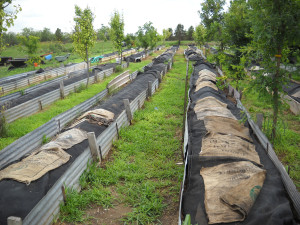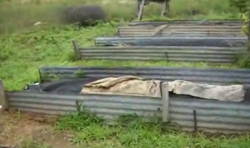Be a Worm Farmer
5 Important Things to know about Raising Worms…
- Proper Moisture – You will want to install a drip irrigation system. The rows need to be kept moist, but not runny.
- Proper Feed – Jerry feeds horse manure. The horse manure keeps the soil loose and is great nutrition for the worms.
- Know when to expand – Once your worm bed is established as the worms multiply, you will want to start a new bed and transfer some of the worms from the established bed to the new bed.
- Each Earthworm lays an egg capsule – As you are sorting through the worm castings, you can separate the egg capsules and add to your new bed.
- An egg capsule hatches 4 earthworms every 3 weeks – The worms multiply rapidly and it’s important not to over-crowd them.
What is the best kind of worm to raise?
 There are a couple of different worms…a white worm and the red wiggler. If you take just any worm and move it into another location, it could die. But the red wiggler is a good worm to raise because it’s got a rapid reproduction cycle, they are a voracious feeder and they work the top 3 to 4” of soil where the feeder roots are. Fishermen prefer to use the Red Wiggler Worm as bait because it’s a native worm, making it easy to dig up and they are not so fragile in transport.
There are a couple of different worms…a white worm and the red wiggler. If you take just any worm and move it into another location, it could die. But the red wiggler is a good worm to raise because it’s got a rapid reproduction cycle, they are a voracious feeder and they work the top 3 to 4” of soil where the feeder roots are. Fishermen prefer to use the Red Wiggler Worm as bait because it’s a native worm, making it easy to dig up and they are not so fragile in transport.
How do you build a worm bed?
 When building a worm bed you need to form your individual worm rows. Jerry uses metal stakes on either side of a piece of metal siding. He fills the bed up 3 or 4” deep with horse manure, which keeps the soil loose. He then takes about 3” of the top of an existing worm bed and moves it to the new bed. He adds a layer of horse manure for feed and installs a drip irrigation line to keep the bed moist. It’s very important to keep the bed moist, but not runny.
When building a worm bed you need to form your individual worm rows. Jerry uses metal stakes on either side of a piece of metal siding. He fills the bed up 3 or 4” deep with horse manure, which keeps the soil loose. He then takes about 3” of the top of an existing worm bed and moves it to the new bed. He adds a layer of horse manure for feed and installs a drip irrigation line to keep the bed moist. It’s very important to keep the bed moist, but not runny.
Watch my interview with Jerry Schiller, as he explains more about the difference in worms, how to build a worm bed, and he shows his healthy worms.
{ 0 comments… add one now }